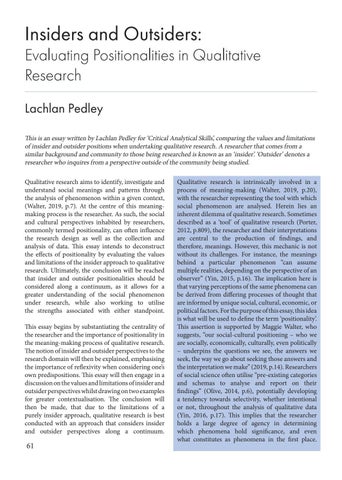Insiders and Outsiders: Evaluating Positionalities in Qualitative Research Lachlan Pedley This is an essay written by Lachlan Pedley for ‘Critical Analytical Skills’, comparing the values and limitations of insider and outsider positions when undertaking qualitative research. A researcher that comes from a similar background and community to those being researched is known as an ‘insider’. ‘Outsider’ denotes a researcher who inquires from a perspective outside of the community being studied. Qualitative research aims to identify, investigate and understand social meanings and patterns through the analysis of phenomenon within a given context, (Walter, 2019, p.7). At the centre of this meaningmaking process is the researcher. As such, the social and cultural perspectives inhabited by researchers, commonly termed positionality, can often influence the research design as well as the collection and analysis of data. This essay intends to deconstruct the effects of positionality by evaluating the values and limitations of the insider approach to qualitative research. Ultimately, the conclusion will be reached that insider and outsider positionalities should be considered along a continuum, as it allows for a greater understanding of the social phenomenon under research, while also working to utilise the strengths associated with either standpoint. This essay begins by substantiating the centrality of the researcher and the importance of positionality in the meaning-making process of qualitative research. The notion of insider and outsider perspectives to the research domain will then be explained, emphasising the importance of reflexivity when considering one’s own predispositions. This essay will then engage in a discussion on the values and limitations of insider and outsider perspectives whilst drawing on two examples for greater contextualisation. The conclusion will then be made, that due to the limitations of a purely insider approach, qualitative research is best conducted with an approach that considers insider and outsider perspectives along a continuum.
61
Qualitative research is intrinsically involved in a process of meaning-making (Walter, 2019, p.20), with the researcher representing the tool with which social phenomenon are analysed. Herein lies an inherent dilemma of qualitative research. Sometimes described as a ‘tool’ of qualitative research (Porter, 2012, p.809), the researcher and their interpretations are central to the production of findings, and therefore, meanings. However, this mechanic is not without its challenges. For instance, the meanings behind a particular phenomenon “can assume multiple realities, depending on the perspective of an observer” (Yin, 2015, p.16). The implication here is that varying perceptions of the same phenomena can be derived from differing processes of thought that are informed by unique social, cultural, economic, or political factors. For the purpose of this essay, this idea is what will be used to define the term ‘positionality’. This assertion is supported by Maggie Walter, who suggests, “our social-cultural positioning – who we are socially, economically, culturally, even politically – underpins the questions we see, the answers we seek, the way we go about seeking those answers and the interpretation we make” (2019, p.14). Researchers of social science often utilise “pre-existing categories and schemas to analyse and report on their findings” (Olive, 2014, p.6), potentially developing a tendency towards selectivity, whether intentional or not, throughout the analysis of qualitative data (Yin, 2016, p.17). This implies that the researcher holds a large degree of agency in determining which phenomena hold significance, and even what constitutes as phenomena in the first place.









